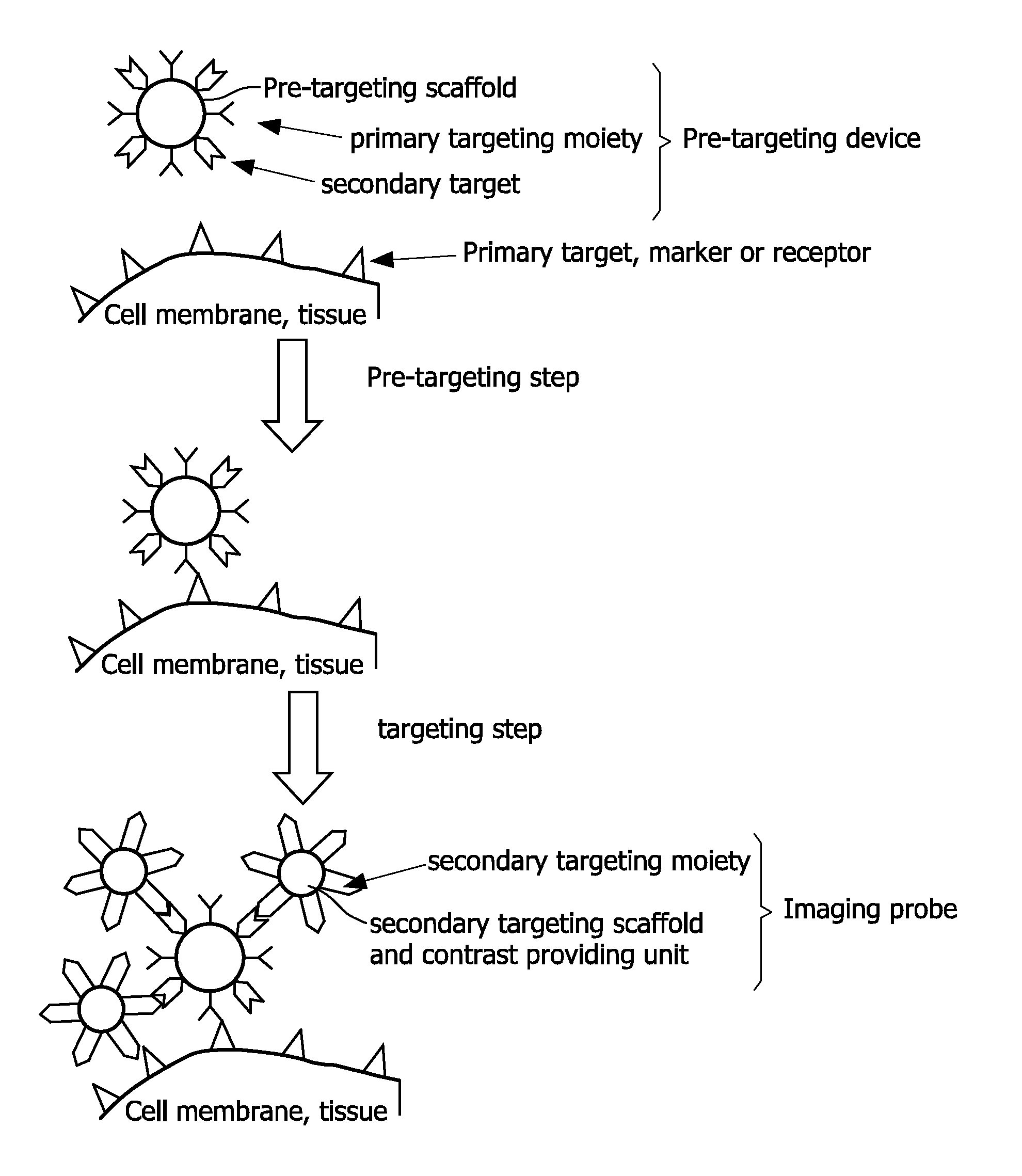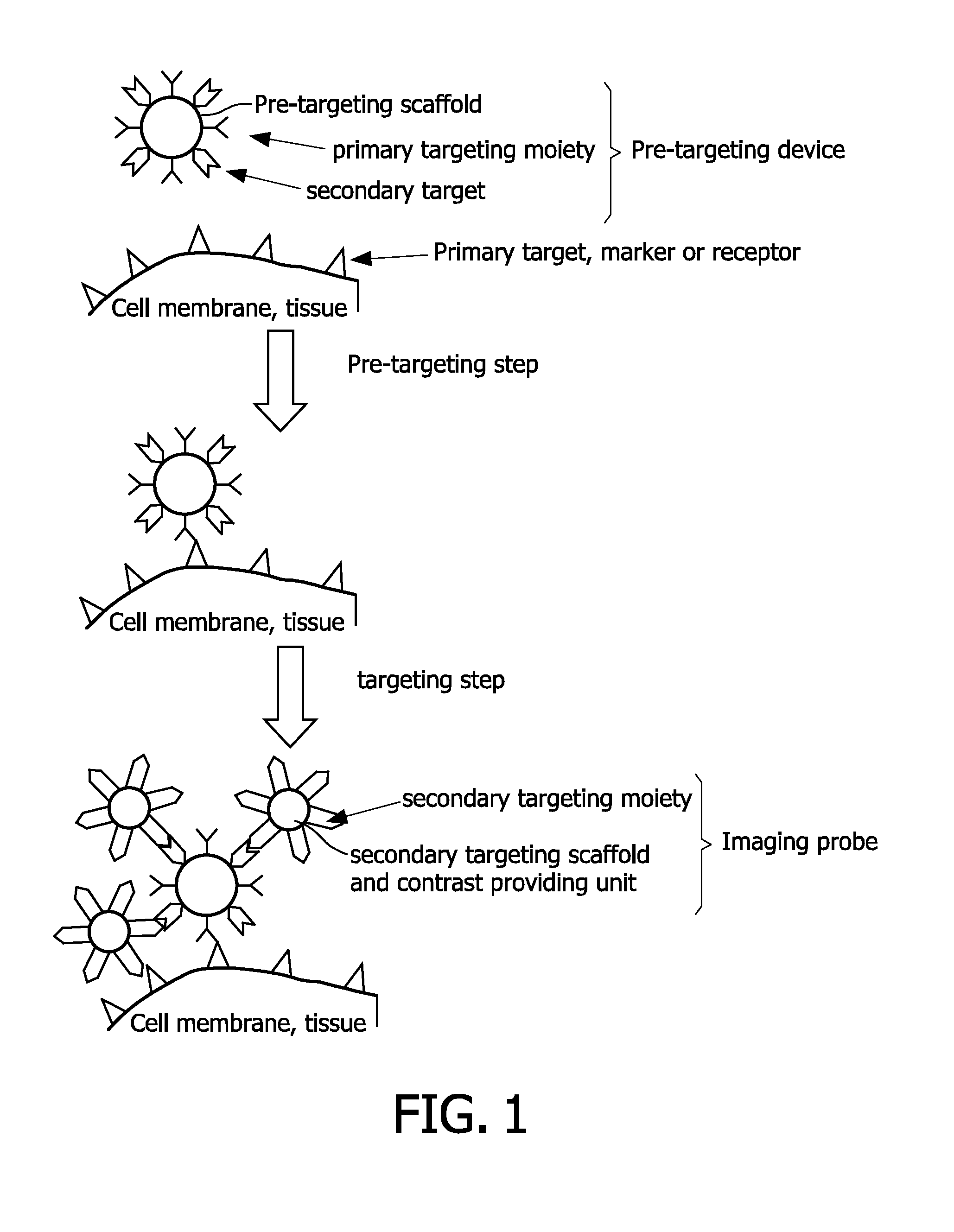Pretargeting kit, method and agents used therein
a technology of pretargeting and kit, applied in the field of pretargeting methods, can solve the problems of pre-targeting approaches, small probes, and remained out of reach
- Summary
- Abstract
- Description
- Claims
- Application Information
AI Technical Summary
Benefits of technology
Problems solved by technology
Method used
Image
Examples
example 1
[0099]As an example to link the tetrazine derived moiety to an antibody as outlined in FIG. 3a, a molecule 1 (see FIG. 4) is prepared. An example of a corresponding probe 2, derived from E-cyclooctene, is presented in FIG. 5. Both molecules contain PEG chains. Molecule 1 comprises an N-hydroxysuccimidyl moiety, that is used to couple the molecule with amino groups present in the antibody. The DOTA derived moiety in 2 can be used to carry a rare earth metal ion such as Gd for MR imaging or Lu-177 for nuclear imaging and therapy (SPECT).
[0100]The synthesis of 1 is outlined in FIG. 4. The starting tetrazine derived molecule 5 is made according to Blackman et al. (Blackman, M L; Royzen, M; Fox, J M, Journal of The American Chemical Society, 2008, 130 (41), 13518-19). It is converted to the acid 6 by reaction with succinic anhydride followed by formation of its N-hydroxysuccimidyl ester 7. This N-hydroxysuccimidyl ester is used to form acid 9 by reaction with the commercially available (...
example 2
[0102]As compared to Example 1, this example illustrates the inverse pair of molecules namely, 1) the E-cyclooctene derivative 3 meant to form the pretargeting moiety after conjugating to the antibody and, 2) the tetrazine / DOTA derived probe 4 that can serve as the Effector Probe as outlined in FIG. 3b, are shown in FIGS. 6 and 7, respectively.
[0103]E-cyclooctene derivative 3 is formed by reaction of the commercially available (IRIS biochem) PEG derivative 8 with N-hydroxysuccimidyl ester 14 (see FIG. 5) to form acid 19, followed by formation of the N-hydroxysuccimidyl derivative out of this acid.
[0104]The synthesis of the tetrazine / DOTA derived probe 4 is outlined in FIG. 7. This probe is made by reaction of the DOTA and PEG derived amine 18 (see FIG. 5) with N-hydroxysuccimidyl ester 7 (see FIG. 4).
example 3
In Vivo Imaging
[0105]All reagents and solvents were obtained from commercial sources (Sigma-Aldrich, Acros, ABCR, Invitrogen, and Merck for reagents, Biosolve, Merck and Cambridge Isotope Laboratories for normal and deuterated solvents) and used without further purification unless stated otherwise. 1-Amino-3,6,9,12,15,18,21,24,27,30,33,36-dodecaoxanonatriacontan-39-oic acid (S11) and tert-butyl (35-amino-3,6,9,12,15,18,21,24,27,30,33-undecaoxapentatriacontyl)carbamate (S3) were obtained from Polypure (Norway) and Iris Biotech (Germany), respectively. 2,2′,2″-(10-(2-((2,5-Dioxopyrrolidin-1-yl)oxy)-2-oxoethyl)-1,4,7,10-tetraazacyclododecane-1,4,7-triyl)triacetic acid (S6) as a salt with HPF6 and approximately 3 eq. of trifluoroacetic acid (TFA) was obtained from Macrocyclics (USA). Rituximab solutions (MabThera®) were purchased from Roche (Switzerland). [111In]Indium chloride and sodium [125I]iodide solutions were purchased from PerkinElmer (USA). Water was distilled and deionized (18...
PUM
| Property | Measurement | Unit |
|---|---|---|
| Length | aaaaa | aaaaa |
| Length | aaaaa | aaaaa |
| Length | aaaaa | aaaaa |
Abstract
Description
Claims
Application Information
 Login to View More
Login to View More - R&D
- Intellectual Property
- Life Sciences
- Materials
- Tech Scout
- Unparalleled Data Quality
- Higher Quality Content
- 60% Fewer Hallucinations
Browse by: Latest US Patents, China's latest patents, Technical Efficacy Thesaurus, Application Domain, Technology Topic, Popular Technical Reports.
© 2025 PatSnap. All rights reserved.Legal|Privacy policy|Modern Slavery Act Transparency Statement|Sitemap|About US| Contact US: help@patsnap.com



